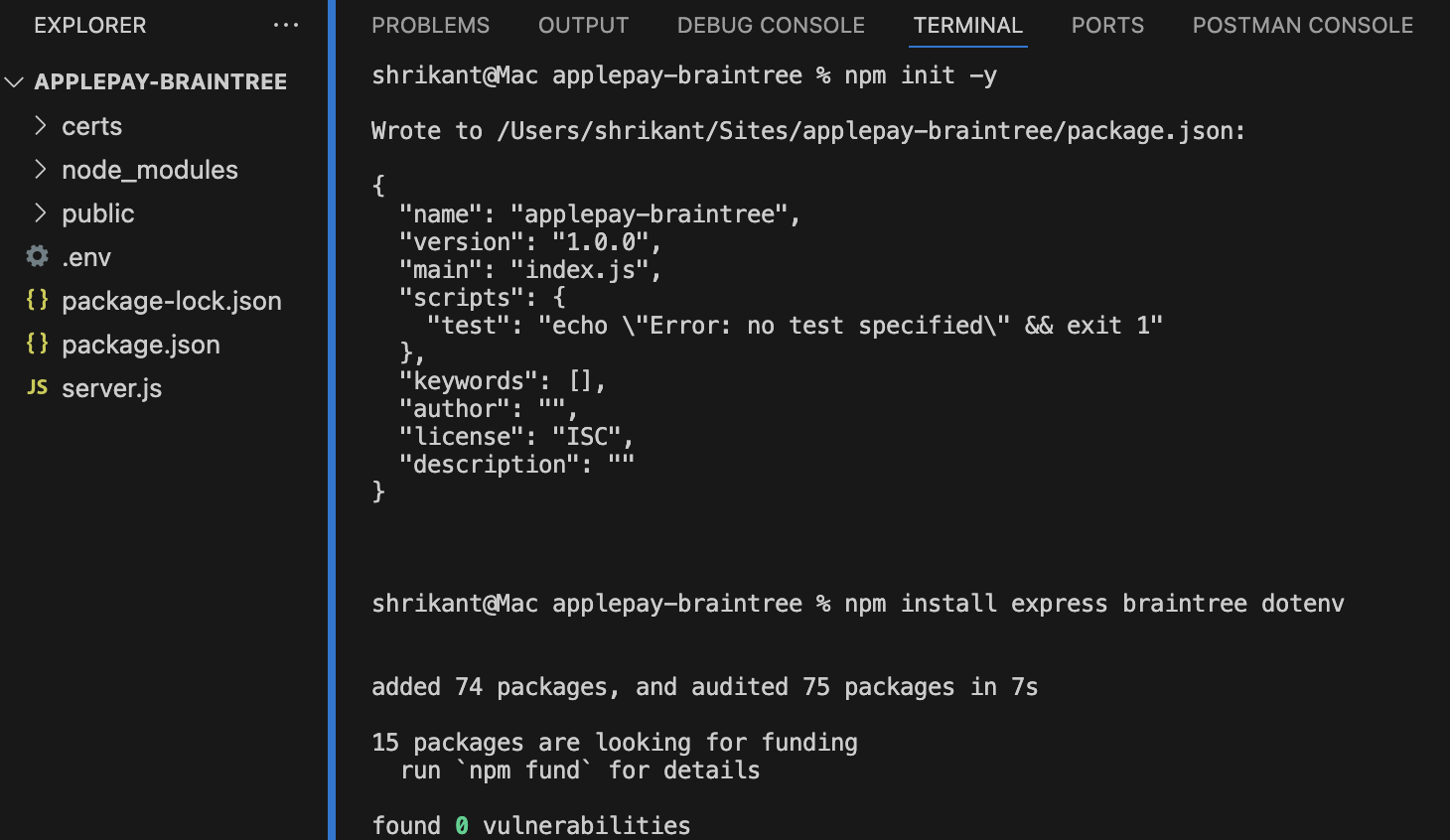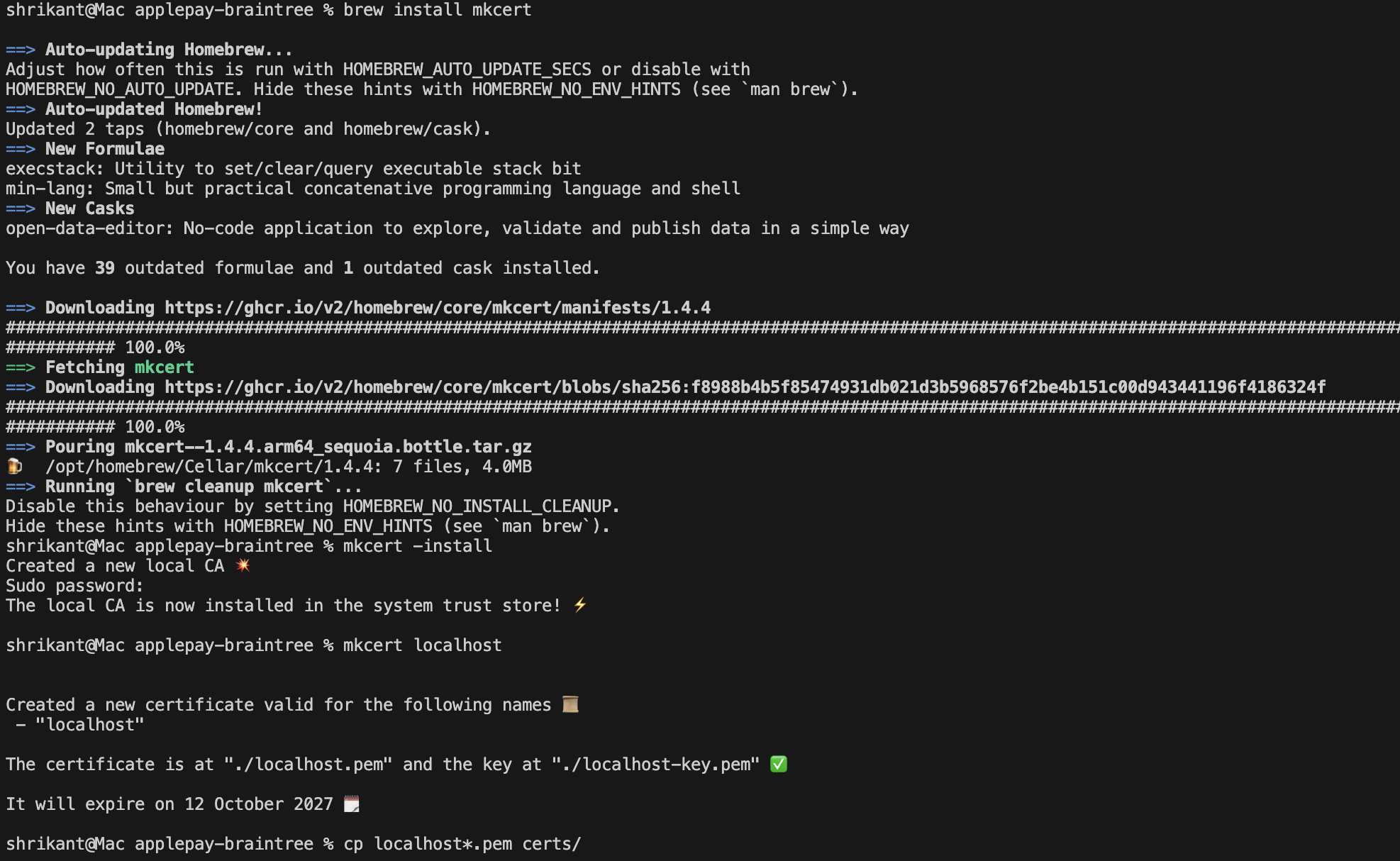If you want to accept Apple Pay payments on your website using Braintree, you need a secure HTTPS server and a simple backend. In this guide, I’ll show you how to build it step-by-step with Node.js, Express, and Braintree — including how to generate a local SSL certificate for HTTPS.
Requirements
- Node.js & npm installed
- Braintree sandbox account
- macOS, Linux, or Windows with
mkcertinstalled (or OpenSSL)
Step 1: Create Project Structure
mkdir applepay-braintree
cd applepay-braintree
npm init -y
npm install express braintree dotenvStructure
applepay-braintree/
├─ certs/
├─ public/
│ └─ index.html
├─ .env
├─ server.js
├─ package.json
Step 2: Get Braintree Sandbox Keys
- Sign in to your Braintree Sandbox.
- Get your
Merchant ID,Public Key, andPrivate Key. - Add them to a
.envfile:
BRAINTREE_MERCHANT_ID=your_merchant_id
BRAINTREE_PUBLIC_KEY=your_public_key
BRAINTREE_PRIVATE_KEY=your_private_keyStep 3: Generate Local SSL Certificates
Use mkcert to create trusted local certs.
brew install mkcert
mkcert -install
mkcert localhost
cp localhost*.pem certs/Copy the generated .pem files to a certs/ folder:
certs/
├─ cert.pem (rename the .pem file)
├─ key.pem (rename the -key.pem file)
Step 4: Create server.js
Here’s your full Node.js server with HTTPS, Braintree, and Express:
require('dotenv').config();
const express = require('express');
const braintree = require('braintree');
const path = require('path');
const fs = require('fs');
const https = require('https');
const app = express();
const port = 3000;
// HTTPS options - make sure these files exist!
const options = {
key: fs.readFileSync('./certs/localhost-key.pem'),
cert: fs.readFileSync('./certs/localhost.pem')
};
// Braintree Gateway with your real environment vars
const gateway = new braintree.BraintreeGateway({
environment: braintree.Environment.Sandbox,
merchantId: process.env.BRAINTREE_MERCHANT_ID,
publicKey: process.env.BRAINTREE_PUBLIC_KEY,
privateKey: process.env.BRAINTREE_PRIVATE_KEY
});
// Middleware for static files + JSON body
app.use(express.static('public'));
app.use(express.json());
// Serve HTML page
app.get('/', (req, res) => {
res.sendFile(path.join(__dirname, 'public/index.html'));
});
// Generate client token
app.get('/client_token', async (req, res) => {
try {
const response = await gateway.clientToken.generate({});
res.send(response.clientToken); // CORRECT — send the generated token
} catch (err) {
console.error('Failed to generate client token:', err);
res.status(500).send('Could not generate client token');
}
});
// Handle payment
app.post('/checkout', async (req, res) => {
const nonceFromClient = req.body.paymentMethodNonce;
const amount = req.body.amount; // Get amount dynamically from client
if (!amount) {
return res.status(400).send({ success: false, message: 'Missing amount' });
}
const saleRequest = {
amount: amount,
paymentMethodNonce: nonceFromClient,
options: { submitForSettlement: true }
};
try {
const result = await gateway.transaction.sale(saleRequest);
if (result.success) {
res.send({ success: true, transactionId: result.transaction.id });
} else {
console.error('Transaction failed:', result);
res.send({ success: false, message: result.message });
}
} catch (err) {
console.error('Error during checkout:', err);
res.status(500).send({ success: false, message: 'Server error' });
}
});
// Start HTTPS server
https.createServer(options, app).listen(port, () => {
console.log(`HTTPS server running at https://localhost:${port}`);
});
Step 5: Create public/index.html
Add a simple page with the Braintree Apple Pay button.
<!DOCTYPE html>
<html lang="en">
<head>
<meta charset="UTF-8" />
<title>Apple Pay with Braintree - Dynamic Product</title>
<script src="https://js.braintreegateway.com/web/3.92.2/js/client.min.js"></script>
<script src="https://js.braintreegateway.com/web/3.92.2/js/apple-pay.min.js"></script>
<style>
body {
font-family: sans-serif;
text-align: center;
padding: 50px;
}
.product-card {
max-width: 300px;
margin: 0 auto 30px auto;
border: 1px solid #ccc;
border-radius: 8px;
padding: 16px;
box-shadow: 0 2px 5px rgba(0,0,0,0.1);
}
.product-card img {
max-width: 100%;
height: auto;
}
#apple-pay-button {
width: 250px;
margin: 0 auto;
}
#result {
margin-top: 20px;
font-weight: bold;
}
</style>
</head>
<body>
<h1>Apple Pay Checkout</h1>
<!-- Product Card -->
<div class="product-card" data-price="19.99">
<img src="https://fastly.picsum.photos/id/4/5000/3333.jpg?hmac=ghf06FdmgiD0-G4c9DdNM8RnBIN7BO0-ZGEw47khHP4" alt="Product Image">
<h2 class="product-title">Sample Product</h2>
<p class="product-description">This is a simple description of the product you’re buying.</p>
<p class="product-price">$19.99</p>
</div>
<!-- Apple Pay Button -->
<div id="apple-pay-button"></div>
<div id="result"></div>
<!-- JS Integration -->
<script>
fetch('/client_token')
.then(response => response.text())
.then(clientToken => {
braintree.client.create({
authorization: clientToken
}, function (clientErr, clientInstance) {
if (clientErr) {
console.error(clientErr);
return;
}
braintree.applePay.create({
client: clientInstance
}, function (applePayErr, applePayInstance) {
if (applePayErr) {
console.error(applePayErr);
return;
}
if (!window.ApplePaySession || !ApplePaySession.canMakePayments()) {
document.getElementById('result').innerText = 'Apple Pay is not available.';
return;
}
const button = document.createElement('button');
button.className = 'apple-pay-button';
button.style.cssText = 'appearance: -apple-pay-button; -webkit-appearance: -apple-pay-button; width: 100%; height: 44px;';
button.onclick = function () {
// Get product price dynamically
const productCard = document.querySelector('.product-card');
const totalAmount = productCard.getAttribute('data-price') || '0.00';
const paymentRequest = applePayInstance.createPaymentRequest({
total: { label: 'Your Company', amount: totalAmount }
});
const session = new ApplePaySession(3, paymentRequest);
session.onvalidatemerchant = function (event) {
applePayInstance.performValidation({
validationURL: event.validationURL,
displayName: 'Your Company'
}, function (err, merchantSession) {
if (err) {
console.error(err);
session.abort();
return;
}
session.completeMerchantValidation(merchantSession);
});
};
session.onpaymentauthorized = function (event) {
applePayInstance.tokenize({
token: event.payment.token
}, function (err, payload) {
if (err) {
console.error(err);
session.completePayment(ApplePaySession.STATUS_FAILURE);
return;
}
fetch('/checkout', {
method: 'POST',
headers: { 'Content-Type': 'application/json' },
body: JSON.stringify({ paymentMethodNonce: payload.nonce, amount: totalAmount })
})
.then(response => response.json())
.then(result => {
if (result.success) {
session.completePayment(ApplePaySession.STATUS_SUCCESS);
document.getElementById('result').innerText = 'Payment successful! Transaction ID: ' + result.transactionId;
} else {
session.completePayment(ApplePaySession.STATUS_FAILURE);
document.getElementById('result').innerText = 'Payment failed: ' + result.message;
}
});
});
};
session.begin();
};
document.getElementById('apple-pay-button').appendChild(button);
});
});
});
</script>
</body>
</html>
Step 6: Run your server
node server.jsOpen https://localhost:3000 in Safari on macOS/iOS (Apple Pay only works there).
You’ll see the Apple Pay button and a success message when done!
GitHub Repo
You did it!
- You now have a secure local Node.js project with Apple Pay + Braintree.
- HTTPS is handled with mkcert for local trust.
- You’re ready to deploy with a real SSL for production.
